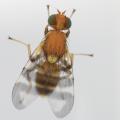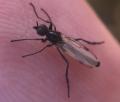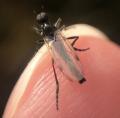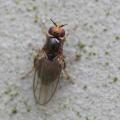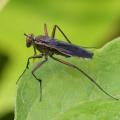Diptera.info :: Identification queries :: Diptera (adults)
Who is here? 1 guest(s)
|
Very small fly on Squash Leaf
|
|
| Stephen |
Posted on 14-08-2006 18:06
|
|
Member Location: West Virginia USA Posts: 1322 Joined: 12.04.05 |
This very small fly was at rest on a squash leaf. Length was 3.8 mm. Open area near woodland, West Virginia, USA. Taken yesterday. ID help appreciated! Stephen attached the following image:  [86.62Kb] --Stephen Stephen Cresswell www.americaninsects.net |
| Stephen |
Posted on 14-08-2006 18:10
|
|
Member Location: West Virginia USA Posts: 1322 Joined: 12.04.05 |
Second image.
Stephen attached the following image: 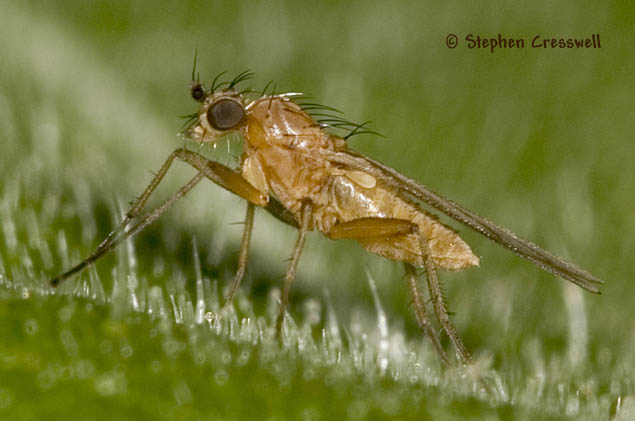 [55.94Kb] --Stephen Stephen Cresswell www.americaninsects.net |
| Nikita Vikhrev |
Posted on 14-08-2006 18:31
|
|
Member Location: Moscow, Russia Posts: 9229 Joined: 24.05.05 |
Even in far and mysterious New World it is still good old Lonchptera of Lonchopteridae. Nikita Nikita Vikhrev - Zool Museum of Moscow University |
|
|
|
| Stephen |
Posted on 15-08-2006 11:10
|
|
Member Location: West Virginia USA Posts: 1322 Joined: 12.04.05 |
Nikita, Thanks very much for the ID! Just for fun, I looked up and found there are four species of Lonchoptera in North America: L. borealis, L. furcata, L. occidentalis, and L. uniseta. I found a 1934 article on North American Lonchopteridae. That author also named 4 species, though he listed dubia rather than furcata. Using his key I came up with L. occidentalis for my picture, though I realize a 1934 key may not be best to use! Thanks again, Nikita! Edited by Stephen on 15-08-2006 11:13 --Stephen Stephen Cresswell www.americaninsects.net |
| Jan Willem |
Posted on 15-08-2006 11:36
|
|
Member Location: Waalwijk, The Netherlands Posts: 2126 Joined: 24.07.04 |
Hi Stephen, According to www.faunaeur.org, Lonchoptera impicta is also known from the Nearctic Region (I have no more details  ). ). L. furcata is a synonym of L. bifurcata! Jan Willem |
|
|
|
| Tony Irwin |
Posted on 15-08-2006 12:40
|
|
Member Location: Norwich, England Posts: 7193 Joined: 19.11.04 |
Hi Stephen Not all 1930's keys are useless - after all, the species haven't evolved that much since then.  However, you are right to be wary of Curran's key. He (or the typesetter) appears to have confused the terms occipital, orbital and frontal. The key is of an odd construction, with a double lead to couplet 4. And he chose an abnormal male for the type of borealis - never a good move, though it happens suprisingly frequently! Anyway I can't identify the specimen in your photo from Curran's key or his descriptions. Edited by Tony Irwin on 15-08-2006 12:46 Tony ---------- Tony Irwin |
|
|
|
| Stephen |
Posted on 15-08-2006 13:12
|
|
Member Location: West Virginia USA Posts: 1322 Joined: 12.04.05 |
Nikita, Jan, Tony, Thanks for your help on this one! Poking around a little further about Lonchoptera impicta in the Nearctic, I found an abstract of a 2005 paper by Canadian John Klymko, proposing that L. borealis is a junior synonym of L. impicta. Usually neartica.com is great for giving lists of currently accepted Nearctic species, but this proposed change is too recent I suppose. I'm not sure what the mechanism is for nearctica.com updating its lists. Anyhow, gentlemen, thanks again for your help! Edited by Stephen on 15-08-2006 13:16 --Stephen Stephen Cresswell www.americaninsects.net |
| crex |
Posted on 15-08-2006 14:01
|
|
Member Location: Sweden Posts: 1996 Joined: 22.05.06 |
John Klymko seems to know a lot about Lonchoptera. Drop him an email with a link to this thread!?  |
|
|
|
| Stephen |
Posted on 31-08-2006 11:30
|
|
Member Location: West Virginia USA Posts: 1322 Joined: 12.04.05 |
John Klymko comments, "The photo you have taken is of Lonchoptera bifurcata (= L. furcata, = L. dubia) It is recognized by the combination of pale post-ocular bristles (the bristles on the head that occur all along the back of the eye), pointed wingtips, and more than one bristle on the leading face of the fore tibia. L. impicta/L. borealis would also have pale pale post oculars and more than one tibial bristle, but would have rather rounded wings. All other described Nearctic species have dark post-oculars, a single tibial bristle, and pointed wings. Notice the photo is of a female (you can see the tip of the rather blunt ovipositor (males would have a phallus bent up under the abdomen). L. bifurcata is a largely parthenogenic species, with only seven males ever being taken in North America (there are populations in Iceland and the UK where males occur regularly). L. bifurcta can be pale tan (as in photos) to black (though the postoculars remain pale), tan most common in summer, black most common in winter. In West Virginia it may well be the only species of Lonchoptera, I have seen many specimens from the south east and don't recall seeing any other species. L. bifurcata is definitely the most common Lonchoptera species in the Nearctic, particularly in disturbed habitats (lawns, ditches etc). It has been my experience that the other species are found in more natural settings, such as riverbanks and swamps, where they to can be quite common." Thanks to one and all for help with this fly! --Stephen Stephen Cresswell www.americaninsects.net |
| Jump to Forum: |




